RESEARCH AND DEVELOPMENT
If you’re serious about your car’s handling performance, you will first be looking at lowering the suspension. In most cases, unless you’re a complete petrolhead, this will be more than adequate. However, if you are a keen driver, you will be able to get far better handling out of your car by fitting a couple of other accessories to it. The first thing you should look at is a strut brace.
When you corner, the whole car’s chassis is twisting slightly. In the front (and perhaps at the back, but not so often) the suspension pillars will be moving relative to each other because there’s no direct physical link between them. They are connected via the car body, which can flex depending on its stiffness.
A strut brace bolts across the top of the engine to the tops of the two suspension posts and makes that direct physical contact. The result is that the whole front suspension setup becomes a lot more rigid and there will be virtually no movement relative to each side. In effect, you’re adding the fourth side to the open box created by the subframe and the two suspension pillars.
Is there a need to have our vehicle chassis strengthened?
The chassis of the car is the part which experiences the most of the abuse from the driver. It is particularly due to the weight transfer of the vehicle body during fast cornering, hard braking or hard acceleration. In some instances, the weight transfer during cornering may cause one side of the vehicle to experience as much as 3 times more force than the other side of the vehicle, causing enormous chassis flex/ vehicle body deformity and twist, consequently causing tires to lose grip. Deformity and twisting of the vehicle chassis during cornering may cause negative handling traits such as understeering and oversteering.
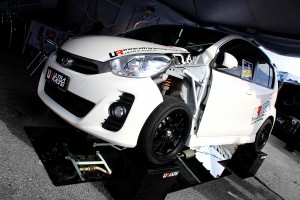
WHAT IS VEHICLE HANDLING

UNDERSTEER
The front wheels are likely to slip towards outside of the turn angle, driver can solve it by turning a little more slightly but the handling is reduced, vehicle’s behavior is less predictable and tires are likely to worn out faster. Understeer often occurs in front wheel drive layout vehicles.

OVERSTEER
The rear wheels are likely to slide towards the outside of the turn more than the front. The driver must correct by steering away from the corner otherwise the vehicle will tend to spin when it has been pushed to its limit. Oversteer often occurs in rear wheel drive layout vehicles.
1. As most modern cars go, car manufacturers employ the FF (Front engine, Front wheel drive) setup for improving driver and passenger safety. The natural behavior of an FF car is to have a slight understeer, due to its heavier front end. Understeer happens when the front wheels lose their traction and won’t turn any sharper, even when the steering is being corrected to turn the car more. This will cause the car to go wide instead of following the line. Understeer can be corrected by stiffening the rear end of the vehicle by adding a Rear Strut Bar and a Rear Anti Roll Bar.
2. Oversteer is when the rear tires lose grip and causing the rear end of the vehicle slides out of a corner. This phenomenon happens particularly to FR (Front engine, Rear wheel drive) or RR (Rear engine, Rear wheel drive) cars. Oversteer can be corrected by stiffening the front end of the vehicle by adding Front Strut Bars and Front Anti Roll Bars.
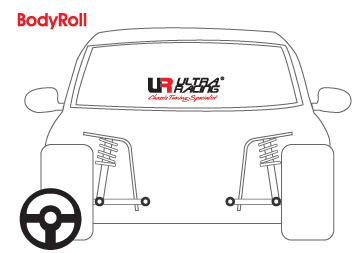
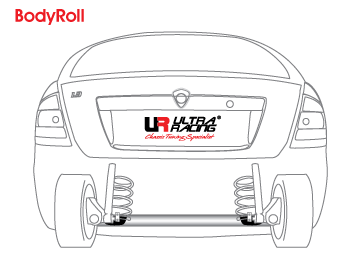
WHAT AFFECTS HANDLING?
When any of the wheels loses contact with the road surface, there will be a deviate in handling; each of the suspension system should keep all wheels on the road surface in spite of hard cornering and in change of steering position. It’s always pleasing that that car can be set for a tiny amount of understeer so that it responds predictably to a turn of a steering wheel and the rear wheels to have a smaller dip angle than the front wheels. However this may not be achievable at all times due to the vehicle load, road condition, weather, speed and this consumes excessive time for the driver to adopt.
STRUT BAR AND LOWER ARM BAR
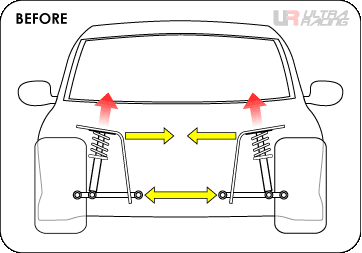
BEFORE :
Part of the shock of impact transfer to the chassis, causing wheel house and lower arm deforming.
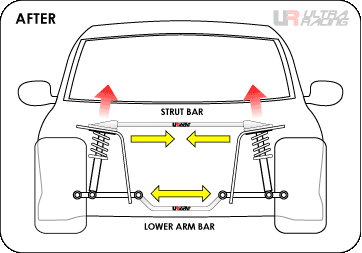
AFTER :
Equip with the Ultra Racing’s strut bar and lower arm bar, both side shock of impact will be neutralized.
WHILE ENTERING AT CORNER
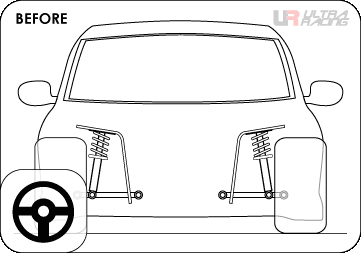
BEFORE :
The weight transfer and force gathering on one side, causing unstable handling and increasing body roll.
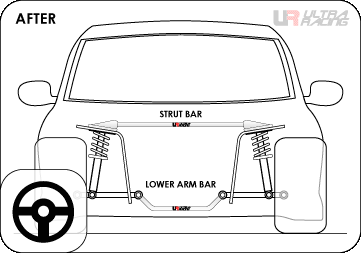
AFTER :
The force will spread out by Ultra Racing’s strut bar and lower arm bar, stabilize the car and provide solid handling.
FENDER BAR
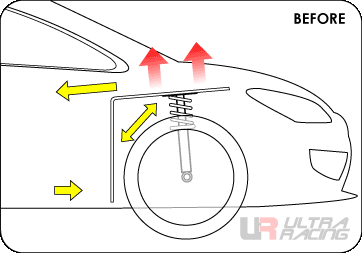
BEFORE :
The joint between A-pillar and front chassis will be push and twist by the greater shock of impact and drag force, causing damage on chassis.
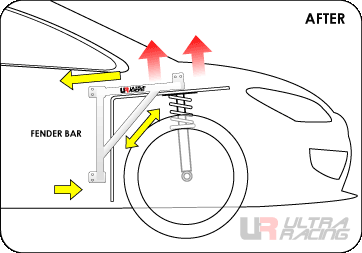
AFTER :
Ultra Racing’s Fender bar will spread out the force and strengthen the section, prevent further damage and offer stable handling. Recommend for user of sport absorber.
SIDE LOWER BAR
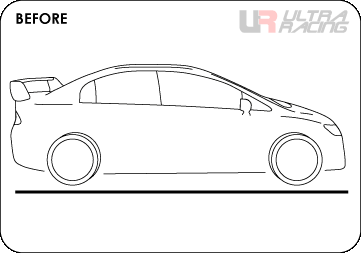
BEFORE :
On uneven / bumpy road, center section chassis will have different level of body flex cause by the weight transfer between front and rear.
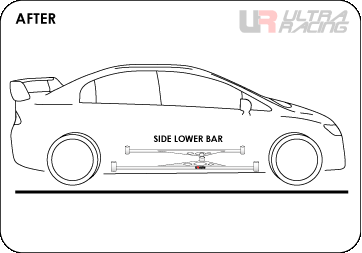
AFTER :
Ultra Racing’s side lower bar will stabilize the weight transfer between front and rear, it can also minimize the damage from side impact.
ANTI ROLL BAR
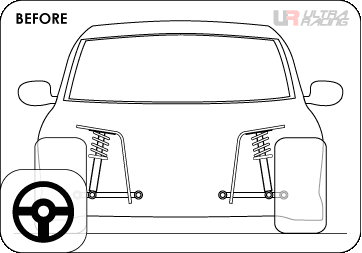
BEFORE :
When turning in corner, the weight transfer will make the car sway a side, causing body roll and more difficult to turn in to a corner, weaken the steering respond.
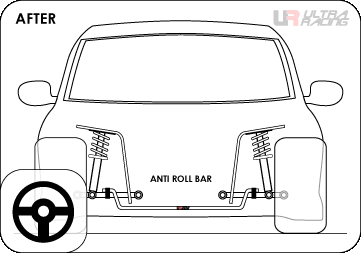
AFTER :
The upgrade version of Ultra Racing’s anti roll bar will be more effectively preventing the car sway a side at cornering, greatly reduce body roll and high stability in cornering.
